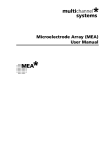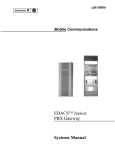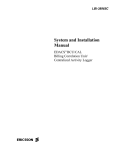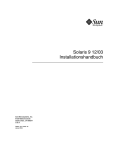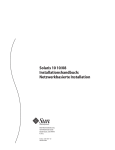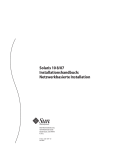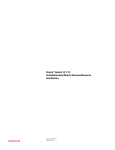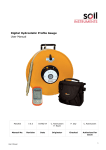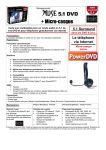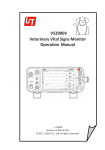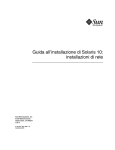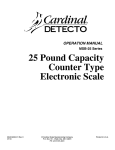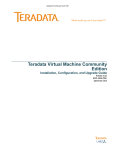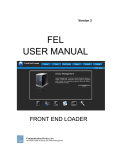Download lbi-38965 - The Repeater Builder`s Technical Information Page
Transcript
LBI-38965 Mobile Communications EDACS BCU/CAL Billing Correlation Unit/ Centralized Activity Logger System and Installation Manual LBI-38965 TABLE OF CONTENTS 1. INTRODUCTION ............................................................................................................................................................. 4 1.1. BCU FUNCTIONAL DESCRIPTION.................................................................................................................... 5 1.2. CAL FUNCTIONAL DESCRIPTION .................................................................................................................... 5 2. PHYSICAL DESCRIPTION AND COMPATIBILITY.................................................................................................... 6 2.1. PHYSICAL SPECIFICATIONS ............................................................................................................................. 6 2.2. BCU/CAL ARCHITECTURE................................................................................................................................. 7 2.3. COMPATIBILITY .................................................................................................................................................. 9 3. SPECIFICATIONS............................................................................................................................................................ 10 3.1. COMMON BCU AND CAL OPERATIONAL SPECIFICATIONS ...................................................................... 10 3.1.1. EDACS System Interface............................................................................................................................... 10 3.1.2. Throughput .................................................................................................................................................... 10 3.1.3. Hard Disk Interface........................................................................................................................................ 10 3.1.4. Operator Interface.......................................................................................................................................... 10 3.2. BCU OPERATIONAL SPECIFICATIONS............................................................................................................ 10 3.2.1. Subscriber Attribute Database ....................................................................................................................... 10 3.2.2. Billing Architecture ....................................................................................................................................... 11 3.2.3. BCU Operation Overview ............................................................................................................................. 11 3.2.3.1. RF Channel Usage (Air Time)............................................................................................................. 12 3.2.3.2. Conversations ...................................................................................................................................... 12 3.2.3.3. Group Billing Mode ............................................................................................................................ 12 3.2.3.4. Input Messages .................................................................................................................................... 12 3.2.3.5. Time Synchronization.......................................................................................................................... 13 3.2.3.6. Output Records.................................................................................................................................... 13 3.2.3.7. BCU Configuration Files..................................................................................................................... 13 3.2.3.8. Operator Functions .............................................................................................................................. 14 3.2.3.9. Database Elements............................................................................................................................... 14 3.2.3.10. Call Processing .................................................................................................................................. 15 3.2.3.11. Call Detail Records............................................................................................................................ 15 This manual is published by Ericsson GE Mobile Communications Inc., without any warranty. Improvements and changes to this manual necessitated by typographical errors, inaccuracies of current information, or improvements to programs and/or equipment, may be made by Ericsson GE Mobile Communications Inc., at any time and without notice. Such changes will be incorporated into new editions of this manual. No part of this manual may be reproduced or transmitted in any form or by any means, electronic or mechanical, including photocopying and recording, for any purpose, without the express written permission of Ericsson GE Mobile Communications Inc. Copyright© August 1994, Ericsson GE Mobile Communications Inc. 2 LBI-38965 TABLE OF CONTENTS (Cont.) 3.3. CAL OPERATIONAL SPECIFICATIONS............................................................................................................ 16 3.3.1. System Manager Interface ............................................................................................................................. 16 3.3.2. Protocol Supported........................................................................................................................................ 16 3.3.3. CAL Operation Overview.............................................................................................................................. 17 3.3.4. Additional Product Features .......................................................................................................................... 17 4. INSTALLATION .............................................................................................................................................................. 18 4.1. HARDWARE INSTALLATION ............................................................................................................................ 18 4.2. SOFTWARE INSTALLATION.............................................................................................................................. 19 4.2.1. Distribution Media ........................................................................................................................................ 19 4.2.1.1. User Configuration Files ..................................................................................................................... 20 4.2.2. Initial Installation .......................................................................................................................................... 24 4.2.2.1. First-Time Configuration..................................................................................................................... 27 4.2.2.2. System Disk Booting........................................................................................................................... 29 4.2.2.3. Proper System Shutdown .................................................................................................................... 30 4.2.3. Software Upgrades ........................................................................................................................................ 31 4.3. CAL TERMINAL SERVER CONFIGURATION.................................................................................................. 31 APPENDIX A EDACS BILLING (CDR) FORMAT............................................................................................................. A-1 APPENDIX B PHYSICAL CONFIGURATION DETAILS ................................................................................................. B-1 APPENDIX C FAULT TOLERANCE................................................................................................................................... C-1 3 LBI-38965 1. INTRODUCTION This manual contains installation instructions, physical and functional descriptions, specifications, and usage information for the Enhanced Digital Access Communications System (EDACS) Billing Correlation Unit and the Centralized Activity Logger (BCU/CAL). A block diagram of the BCU/CAL is shown below. The BCU/CAL works as a subsystem attached to an Ericsson GE Integrated Multisite and Console Controller (IMC) and can be set to operate as a BCU, a CAL, or both. Each IMC node must have its own BCU/CAL. BCU and CAL are two separate capabilities which can run independently of each other on the same machine, yet still utilize resources and utilities common to both. Additional information for BCU/CAL can be found in the following publication: l LBI-38967, EDACS Billing Correlation Unit/Centralized Activity Logger User Interface Manual RF System Console Terminal RF System Downlink MIM DAT (Optional) BCU CAL C A M Area IMC High-Speed HDLC Link R S -422 Ethernet TCP/IP WAN E m ulex T e rm in al S erv ers C u sto m er Billing C om p u te r MIM E m ulex T erm inal S erv ers 16 R S -23 2 16 R S -23 2 DEC T erm in al S e rv ers DEC T e rm in al S e rv ers D E C N et LA N S y stem M ana ger T he d o tte d lines en c lo se the C A L-sp ecific in te rfac es of the B C U /C A L . Figure 1 - BCU/CAL Architecture 4 ED ACS N e two rk M anag er LBI-38965 1.1. BCU FUNCTIONAL DESCRIPTION The main function of the BCU is to generate call detail records (CDRs) to be transferred to an external billing system for invoice generation. To accomplish this, the BCU scans an input stream of activity messages supplied by the IMC, archives these messages in their raw form, uses those messages which indicate channel assignment and channel drop events to calculate air time, and then generates the CDR. Call Types Supported All EDACS call types except for the following are supported by the BCU: 1. 2. 3. 4. Console calls. Conventional site calls. Local interconnect calls. Non-EDG data calls. 1.2. CAL FUNCTIONAL DESCRIPTION EDACS system administrators require both site monitor and activity download capabilities. These functions are normally supported by the System Manager in conjunction with the Site Controller at each Radio Frequency (RF) System. The CAL provides this capability for EDACS not equipped with a Site Controller. 1. Site Monitor Provides the system operator at a System Manager terminal with a real-time display of the calls in progress on the RF channels at the selected trunked system. 2. Activity Download Call activity and system status information are collected by the CAL and buffered in internal memory. Once an operator-defined buffer content threshold is exceeded, the CAL initiates a download of buffer contents to the System Manager. The downloaded information is used to prepare traffic reports on system usage. In existing EDACS networks, the System Manager communicates with Site Controllers at RF systems using modems and dial-up or leased line connections, routed through a DECServer terminal server. A communications session is set up via a DECServer port between the System Manager and the Site Controller. The System Manager associates the DECServer physical port number with the Site Controller's identity. Since the IMC is already connected to all the sites, it has centrally available much of the data that individual site controllers normally output to the system managerfor all the sites. The CAL connects to the IMC and demultiplexes incoming call activity information messagesthe same messages that the BCU uses for billinginto activity download data and site monitor data to send to a system manager using site controller protocol. The CAL uses two Internet Protocol (IP) terminal servers on the local area network (LAN) to communicate with the System Manager's DECServer(s). Up to 32 RS-232 asynchronous serial connections are available, 16 per terminal server. One System Manager DECServer port and one IP terminal server port are required per EDACS system being monitored by CAL. Call Types Supported All EDACS call types except for the following are supported by the CAL: 1. 2. 3. 4. Console calls. Conventional site calls. Local interconnect calls. Non-EDG data calls. 5 LBI-38965 2. PHYSICAL DESCRIPTION AND COMPATIBILITY This section outlines the specifications, depicts the physical architecture, and provides compatibility information for the BCU/CAL. Software for the BCU and the CAL are merged into one software package. Feature encryption allows or disallows BCU or CAL functionality. The two products can also run on the same hardware platform with minor additions for CAL. 2.1. PHYSICAL SPECIFICATIONS General Specifications BCU/CAL: ELMA VME System 12 7-slot enclosure with PSU and integral cooling fan TVME 147 single-board computer with TVME 712/M Transition Module Formation WANServer fv5310 Maxtor MXT-1240S 1.2 GB 3½" half-height 8.5ms hard disk drive, internal Teac FD235HS-711 1.44 MB 3½" half-height floppy disk drive, internal Tape Drive (Optional with BCU only): Archive/Maynard 4324NP 4/8 GB 3½" half-height 4mm digital audio tape (DAT) drive, internal Console Terminal: DEC VT100 or compatible console terminal Terminal Servers (CAL only) Emulex Performance Series P2516-SLTL (16 ports per terminal server) Power Supply BCU/CAL: 115/230 VAC, 47-63 Hz, 500 W Physical (EGE Standard Cabinet) BCU/CAL: 6 rack units: 26.67 cm (10.5 in.) high x 48.26 cm (19 in.) wide x 49.99 cm (19.68 in.) deep Environmental Storage Temperature: Operating Temperature: Operating Altitude: Shipping Altitude: Relative Humidity: 6 -40 to +85°C 0 to 40°C (ambient) < 15,000 feet < 50,000 feet < 90% (non-condensing) LBI-38965 2.2. BCU/CAL ARCHITECTURE The BCU/CAL's internal architecture is shown in Figure 2. The individual components and their primary functions are outlined below. VMEbus Backplane P2 Adapter Board RS-232 Appl. SW HDLC Common VME Platform From CAM Ethernet LAN SCSI Formation WANServer Communications Module TVME712/M Transition Module Floppy Disk Tape Drive TVME147 CPU Administrative Terminal Hard Disk To System Manager Terminal Servers (CAL Only) Figure 2 - BCU/CAL Architecture 7 LBI-38965 The BCU/CAL is based on a VMEbus computing platform with the following components: CPU Technico TVME 147 single-board computer based on a 68030 microprocessor • • • • Supports BCU/CAL application processing Interfaces to hard disk, floppy disk, and tape drive via an on-board small computer systems interface (SCSI) with a connector on the transition module Interfaces to the console terminal via an RS-232 serial port with a connector on the transition module Network physical connection is 802.3 Ethernet, 10 BASE-15 (Thick Wire). A MAU may be used for connection to a Thin Wire (coaxial) network Internal Drives Hard Disk: 3½" 1.2 GB • • • Provides configuration parameter storage Provides call detail record (CDR) storage Provides raw activity record (RAR) buffering/storage Floppy Disk: 3½" 1.44 MB • Used for application program updates Tape: 3½" 4/8 GB 4mm DAT • • • Provides call detail record (CDR) file archival storage Provides general purpose file interchange with UNIX UNIX Tar format, 512-byte tape block size, no data compression Communications Module Formation WANServer fv5310 • Interfaces the BCU/CAL via high-speed high-level data link control (HDLC) link to the Central Activity Module (CAM) in the Integrated Multisite and Console Controller (IMC) System Manager Interface (CAL only) One or Two Emulex Performance Series P2516-SLTL Terminal Servers • • 8 Communicates with the BCU/CAL over the network and with the System Manager over RS-232 Converts between transmission control protocol (TCP) sockets and asynchronous serial protocol LBI-38965 2.3. COMPATIBILITY The BCU/CAL software is compatible with the following IMC and System Manager versions: • • • • IMC Software V4.01 and later IMC CAM Controller Board (P/N 19D903299P3) Networks/Data VME Controller ROM V1.03 MicroVax System Manager Software V3.01 and later (CAL only) The System Manager Software version requirement applies only to the CAL feature. The BCU feature operates independent of the System Manager. Thus, the BCU is “compatible” with any System Manager software version. Backwards Compatibility The BCU/CAL will function with IMC software versions down to V3.04, with minor performance degradation. The following features are not available with IMC software versions older than V4.01: BCU/CAL • The User Interface “stats” command will not provide information regarding queued, denied, system busy, and convert-to-callee channel events. CAL-Specific • Activity records and site monitoring will not reflect queued, denied, system busy, and convert-to-callee channel events. • The site monitor will not provide current control channel indication. 9 LBI-38965 3. SPECIFICATIONS 3.1. COMMON BCU AND CAL OPERATIONAL SPECIFICATIONS 3.1.1. EDACS System Interface The BCU/CAL interfaces to EDACS via a full duplex port supporting high-level data link control (HDLC) protocol. The BCU/CAL will adapt to the data transmission rate to which the Central Activity Module (CAM) is set to operate (64K or 360K, selectable via CAM dip switches). BCU/CAL Input Data Each raw activity record (RAR) contains the following information: 1. 2. 3. 4. 5. 6. 7. 8. Day and time of event accurate to ±0.1 second Type of event (i.e., assignment or drop) Call type (individual clear voice, group clear voice, individual digital voice, group digital voice, data, etc.) Site number or console number Channel number (to match assignments with drops) Caller ID Callee ID Digitally dialed PSTN digits for outgoing interconnect calls Note: The dialed digits correspond to the digits sent by a radio to the interconnect system to initiate an interconnect call; dual tone multi-frequency (DTMF) overdial digits sent by the radio once an interconnect call is in progress are not registered by the BCU. 3.1.2. Throughput The BCU/CAL's interface to the IMC is capable of receiving a peak data rate of 192 raw activity records (RARs) per second. A buffer stores incoming RARs at the peak rate of 192 RARs per second for a minimum of 300 seconds (5 minutes). 3.1.3. Hard Disk Interface The BCU/CAL provides nonvolatile storage of the BCU/CAL operating software, CDRs, system configuration data, system defaults, and subscriber attributes. The hard disk provides concurrent support of call record processing and the operator interface. 3.1.4. Operator Interface Most BCU/CAL operator functions are capable of being performed without impacting or reducing the capacity of the call processing functions below specified rates. Refer to the User Interface Manual, LBI-38967, for further information. 3.2. BCU OPERATIONAL SPECIFICATIONS This section outlines the specifications that are unique to the BCU personality. 3.2.1. Subscriber Attribute Database Each system subscriber and each group defined on the system is assigned a record in the subscriber attribute database. This database supports a maximum of 16,383 individual subscribers and a maximum of 2048 groups. 10 LBI-38965 3.2.2. Billing Architecture The EDACS billing system architecture is shown in Figure 3. Each IMC is connected to a BCU/CAL via a high-speed serial communications link using HDLC protocol. RF System Console Terminal RF System MIM C BCU A M System Console Terminal Downlink DAT (Optional) RF RF System MIM MIM DAT (Optional) Area IMC BCU C A M MIM Area IMC High-Speed HDLC Link Ethernet TCP/IP WAN StarGate Customer Billing Mainframe To other IMCs The dotted lines enclose one optional setup for a StarGate (multi-node) billing architecture. Figure 3 - Billing Architecture 3.2.3. BCU Operation Overview Each RF system sends all call information to the IMC via the downlink. This is true for single-channel autonomous trunking (SCAT), Conventional Network Interface (CNI), basic EDACS, and RF systems operating in failsoft mode. All call activity information messages received by the IMC are collected by the Central Activity Module (CAM), where each call message is time stamped. These messages, called raw activity records (RARs), are then passed via the high-speed serial link to the BCU/CAL. If activity logging is enabled, the BCU first archives a copy of each RAR received. The BCU then examines each RAR and uses the time stamp values to determine the length of each call. The actual billing algorithm is quite complex and depends on the BCU's keeping a memory of outstanding calls. The output of the billing algorithm is stored to a regular disk file as a series of call detail records (CDR). Activity logging of RARs is a diagnostic capability not required for normal BCU functionality. RAR activity logging consumes disk space and can result in degraded system throughput. Although the feature is provided, its use is strongly discouraged for most users. The CDR format is compatible with Cincinnati Bell Information System’s (CBIS) Cellware billing software. 11 LBI-38965 3.2.3.1. RF Channel Usage (Air Time) The basic unit of RF channel usage for billing purposes is a channel assignment. One or more working RF channels is assigned in response to a request from a subscriber unit (mobile radio, data terminal, etc.). Each channel assignment event results in air time, which is defined as the period of time during which the RF channel or group of channels is in use, repeating the signal from a subscriber unit. If the system is operating in transmission trunked mode, one channel assignment occurs each time the unit is keyed and unkeyed. In a multisite network, more than one channel assignment can occur in a single call—since multiple sites can participate in a call—and a channel is used on each participating site. The air time for such a call is defined as the sum of the air time associated with all of the channel assignments occurring in that call. In a multiple node network (StarGate or MultiLink), a single call may involve channel assignments on sites on more than one node. In theory, these channel assignments are part of the same call. In practice, the BCU deals with data at the node level and does not correlate channel assignment air time from remote nodes. A multiple node call is identified by the StarGate interface ID as the site ID in the CDR; this facilitates the correlation of records across nodes in the external billing system. 3.2.3.2. Conversations If a CDR were created for each call, the data storage requirements for the BCU/CAL would be excessive. For this reason, a different unit of RF channel usage, called a conversation, has been defined. A conversation includes one or more calls. Calls are summed into conversations based on the subscriber (radio) units participating in the calls and the duration of the time interval between the end of one call and the beginning of the subsequent call. The criteria for inclusion in a conversation are explained in detail below. Grouping Calls A set of calls may be grouped into a conversation only if each call involves the same participants and is of the same call type as all other calls in the set. For group calls, only calls made with the same Group Identification (GID) may be linked. In this case, the Logical Identification (LID) of the caller is irrelevant, except for the LID of the first caller in a sequence (this is explained in the next subsection). For individual calls, the caller's LID must be the same as either the caller's or the callee's LID in every other call in the set. Broken Call Sequences A set of calls must occur in an unbroken sequence. A sequence is broken when one of the call participants calls a nonparticipant. For individual calls, this means that either the caller or the callee from the first call in the sequence calls some third party, either a group or individual. For group calls, the sequence is broken if the caller from the first call in the sequence calls a different group or an individual. Note that a subscriber unit may participate in multiple group conversations overlapping in time, as long as that unit was not the first caller in at least one of the conversations. A sequence of calls is also broken when the time interval separating the end of one call and the beginning of the subsequent call in the sequence exceeds an arbitrary value. This value is called the pseudo hang time and is configurable on a unit or group basis in the BCU. 3.2.3.3. Group Billing Mode A group call may be charged to the caller or to the group. The CDR includes a flag which indicates which party to bill. The choice is determined by a billing mode associated with each group ID or by the default billing mode. Individual calls are always charged to the caller, except for land-to-mobile interconnect calls and incoming data calls. In each of these cases, the ID of the caller (or sender of the data) is unknown; thus, the call must be billed to the callee. 3.2.3.4. Input Messages Input to the BCU consists of a stream of activity messages. As a minimum, the messages include all channel assignment events and channel drop events generated on EDACS. This includes channel assignment and drop from the Jessica Private Branch Exchange (PBX) Gateway and StarGate interfaces. 12 LBI-38965 Channel assignment and channel drop messages contain the following information: • • • • • • • Date and time of event to the nearest tenth of a second Type of event (i.e., assignment or drop) Call type (individual clear voice, group clear voice, individual digital voice, group digital voice, data, etc.) Site number or console number Channel number Caller ID Callee ID 3.2.3.5. Time Synchronization The time of channel event value is derived from the IMC's internal clock. This is slaved to the MOM-PC clock, which can be synchronized externally from a WWVB signal, via a Spectracom clock unit. This unit is available as an option to the MOM-PC. The Spectracom unit includes an internal high-stability reference clock, which maintains synchronization even in the event of loss of the WWVB signal for an extended period. This configuration ensures that RAR timestamps are accurate at all times. 3.2.3.6. Output Records The BCU creates CDRs by processing the input messages due to channel assignments and channel drops. The format of a CDR record entry is discussed in detail in Appendix A. Each CDR records the following information about each conversation: • • • • • • • • • The Logical Identification (LID) of the caller The identity of the callee (either LID or GID) The location (node, site, and channel number) of each RF channel involved in the conversation The call type (individual clear voice, group clear voice, individual digital voice, group digital voice, data, etc.) A flag indicating which party to bill (caller or callee) The start time of the first call The elapsed time from the start time until the end of the final call The number of channel assignments included in the conversation The total accumulated air time (Note that this is not the same as the elapsed time because of the pseudo hang time, and the effect of multiple channels per call.) 3.2.3.7. BCU Configuration Files The BCU uses binary configuration files to store various configuration values. The file names and their contents are as follows: File Name SYSTEM.BIN UNIT.BIN GROUP.BIN Contents Specifies system parameters, default pseudo hang times, and billing modes. Specifies the pseudo hang time associated with each LID. Specifies the pseudo hang time and the group billing mode associated with each GID. These files are located in the 1.2/cnfg directory. Since they are stored in binary form, these configuration files can be modified only by using the BCU/CAL Configuration Service (BCS) program, which is described in the User Interface Manual (LBI-38967). The BCU is able to operate with no terminal input by using all default values for configuration parameters. Pending development by Ericsson GE of a system-wide database management strategy, there is a method by which the BCU configuration "database" can be maintained without using BCS to configure each unit manually. 13 LBI-38965 The three configuration files can be created by running BCS on a BCU/CAL used as a master. Then, these files can be copied to the appropriate directory (1.2/cnfg) on a target BCU, and the target will assume the same configuration values. Changes specific to the target must be made either by running BCS on the target or by making the changes on the master, copying the configuration files to the target, then reversing the changes to restore the master to its baseline configuration. NOTE To copy or delete the configuration files from a BCU/CAL, you must NOT be running BCS on that system. BCS keeps all the configuration files open while it is running, thereby preventing them from being deleted or overwritten. 3.2.3.8. Operator Functions An EDACS system operator is able to perform the following functions locally or remotely using a terminal interface program running on the BCU/CAL: • • • • • • Input of default configuration database. Default pseudo hang time. Default group billing mode. Input of configuration data for individual LIDs and/or GIDs to override the default configuration database. (Configuration data may be input for an individual ID or range of IDs.) - LID pseudo hang time. - GID pseudo hang time. - GID group billing mode. Creation of a magnetic tape archive of CDRs. Transfer CDR files from the hard drive to the floppy drive. Refer to LBI-38967 for a detailed explanation of the available operator functions. 3.2.3.9. Database Elements This section describes the elements of the BCU's configuration database. Default Data A set of subscriber default attributes maintained on the system contains the following information: 1. 2. 3. 4. Default unit pseudo hang time (seconds) Default group pseudo hang time (seconds) Default group billing mode (caller or group) Default data call pseudo hang time (seconds) Unit Data Each subscriber can be assigned a record in the subscriber attribute database. This record contains the following information: Pseudo_Hang-Time (seconds). Group Data Each group defined on the system shall be assigned a record in the subscriber attribute database containing the following information: 1. 2. 14 Group pseudo hang time (seconds) Billing mode (group or caller) LBI-38965 3.2.3.10. Call Processing This section contains specifications on the BCU's call processing capability. CDR Processing A record of each conversation is maintained by the system. A conversation is a collection of calls detailed by RARs that have been correlated based upon call participants and caller pseudo hang time. Each CDR contains the following information: 1. 2. 3. 4. 5. 6. 7. 8. 9. 10. 11. Caller billing ID (BID) Callee BID or GID (group ID) Call type (individual, group, Digital Voice, data, interconnect, etc.) Bill flag (caller or callee) Identification of each RF channel (node, site, and channel) Start time of the first call Number of channel assignments included in the conversation Total elapsed time from start time to end of final call Total accumulated node air time to within ±0.5 seconds PSTN number dialed on outgoing interconnect calls PSTN line number on incoming interconnect calls Call Processing CDR Output The call processing software redirects file output to a new file when the current file being written to exceeds a maximum size. The system administrator can set this maximum size. CDR Storage Requirements The BCU is capable of storing all CDRs from the previous 30 days on its internal hard drive. CDR files are maintained on the system for a programmable time period. CDR Processing Errors The call processing software recovers automatically from the following error conditions: 1. 2. 3. 4. 5. Link time-out exceeded Unmatched channel drops Unmatched channel assignments CAM hardware reset WANServer reset RAR Storage Options The system administrator can choose either to store all RARs to the hard drive or to discard RARs after use by the CAL and/or BCU processing software. RAR Storage Requirements The BCU/CAL can store all raw activity records for the previous 24 hours. 3.2.3.11. Call Detail Records A CDR is a series of ASCII characters terminated by a newline (NL) character. The records are variable length, but they contain a fixed length segment, which is always present, followed by zero or more suffix segments. There are two types of suffix segments. The first is an additional site segment, which identifies the sites and channels used in a multisite call. The second type of suffix is a PSTN phone number field, which is appended to a mobile-originated interconnect call record and contains the digits dialed by the caller. 15 LBI-38965 3.3. CAL OPERATIONAL SPECIFICATIONS This section outlines the specifications that are unique to the CAL personality. architecture. Refer to Figure 4 for the CAL 3.3.1. System Manager Interface The CAL interfaces to the System Manager's DECServer(s) via one or two terminal servers capable of supporting up to 32 independent asynchronous RS-232 serial connections. The ports on the CAL's terminal servers are connected to the ports on the System Manager's DECServers via RS-232 cables. 3.3.2. Protocol Supported The CAL is capable of communicating with the System Manager using the System Manager-to-Site Controller (SM-SC) and Site Controller-to-System Manager (SC-SM) protocol defined in EDACS Protocol Specification, System Manager/Site Controller Version 1.1. RF S ystem RF S ystem M IM M IM A rea IM C CAM H igh-S peed H DLC Link (R S-422) C entralized A ctivity Logger (C A L) R S -232 CA L C onsole T erm inal T C P /IP L AN E m ulex T erm inal S erv ers 16 R S -232 D EC T erm inal S erv ers S ystem M anager D E CN et LA N E m ulex T erm inal S erv ers 16 R S-232 DEC T erm inal Serv ers Figure 4 - CAL Architecture 16 LBI-38965 3.3.3. CAL Operation Overview As new RARs enter the system, they are dispatched to an appropriate site handler which reformats and queues the data. When the number of activity records queued exceeds a threshold value obtained from the System Manager at startup, a download request is sent to the System Manager. At any point, the System Manager may log in to the site object and request it to purge its queue of activity messages, start/stop download of activity messages, or start/stop the transmission of monitoring messages. 3.3.4. Additional Product Features Network File System The BCU/CAL can be licensed to function as a network File Server (NFS). This feature allows the BCU/CAL system disk to be mounted by client hosts, such as a billing mainframe computer. The NFS feature is provided at no charge for units licensed for BCU operation. It may be purchased as an additional feature for the CAL. 17 LBI-38965 4. INSTALLATION 4.1. HARDWARE INSTALLATION CAUTION Turn off the power before removing or installing VMEbus boards. Removing or reinstalling the boards while the power is on will damage the boards. This section describes the physical installation of the BCU/CAL. Other configuration is performed during manufacture, and the information necessary is provided in Appendix B. Follow these steps to connect a BCU/CAL to an IMC for the first time (except where indicated otherwise, these steps apply to all configurations; BCU only, CAL only, or BCU and CAL): Using the LAPB cable provided, connect the BCU/CAL's CAM control port 0, a female DB-25 connector located on the rear of the BCU enclosure, to the lower connector on the IMC backplane which corresponds to the slot in which the CAM resides. The cable is keyed so that it fits properly only when it is correctly oriented. BCU/CAL Equipment Rack IMC Equipment Rack 852327G1 903531P1 P2 BCU/CAL CAM Control Port 0 J1 J1 J14 J9 Data Concentrator at BCU/CAL Equipment Rack Audio Concentrator at IMC 19D903628P71 P72 P73 P1 CAM Control This will be plugged into PA2XX on the backplane and will correspond with the slot in which the CAM control card is located. 19D903880P120-129 Figure 5 - BCU/CAL to IMC Next, connect the console terminal to the female DB-25 connector labeled "SERIAL PORT 1/CONSOLE" on the TVME-712/M transition module located in the rear of the BCU/CAL enclosure. (For reference, the BCU/CAL is delivered preconfigured from the factory in a 19-inch rack.) Connect the other end of this cable to the console terminal's "host" port, or equivalent. If a PC is used as the console terminal, then a DB-9 adapter may be needed. In either case, the serial cable for the console is wired straight-through. Configure the console terminal for the communications parameters below. • • • • 18 9600 Baud No Parity 8 Data Bits 1 Stop Bit LBI-38965 If the BCU/CAL is being connected to a network, plug a MAU (either coaxial or twisted pair) into the 15-pin female connector labeled "ETHERNET" on the TVME-712/M transition module on the rear of the BCU/CAL enclosure and attach the MAU to the network. If the BCU/CAL is being connected to a 10BASE-15 (Thick Ethernet) network, no MAU is required. Attach the transceiver cable directly to the 15-pin connector on the transition module. If CAL is to be enabled for this installation, then connect the Emulex P2516 terminal server(s) to the same network segment to which the BCU/CAL is connected and switch on the power. Be sure to wait 5 minutes after applying power to the P2516 before continuing on to the next step. Even though it is a separate unit, the terminal server is an integral part of the CAL. The terminal server must be situated near the VAX System Manger's terminal server (DECServer). The ports on the P2516 connect to the ports on the DECServer with RS-232 cables. The port connections will be different for each installation, depending on which sites will be monitored by CAL. Turn on all power switches and wait for approximately 2 minutes. The following indications signify that the BCU/CAL is functioning properly: • • • • The red LEDs on the BCU/CAL are not illuminated. The amber "STATUS" LED on the TVME-147 is lit dimly or is flashing. The green "RUN" LED on the fv5310 is illuminated. The console terminal displays the message Login: If any of these conditions are not met, then double-check the connections and try to restart the BCU/CAL by switching the power off, waiting 15 seconds, and switching on the power again. If normal operation is not achieved, then leave the power switched on and the network connected. It may be possible to diagnose the BCU/CAL remotely over the network. The personality of the BCU/CAL unit is set during manufacture, but can be changed by using the product utility, which can be run from the BCU/CAL command line after logging in. For details on this utility, see the User Interface Manual (LBI38967). For BCU/CAL operation via the console terminal, refer to the User Interface Manual (LBI-38967). 4.2. SOFTWARE INSTALLATION The following section describes the software distribution, installation, and configuration of the BCU/CAL application(s). 4.2.1. Distribution Media The BCU/CAL software is distributed on four 1.44Mb MS-DOS compatible floppy diskettes. The first three disks contain Ericsson GE executable code, supplied in ASCII S-Record format. The head (first few lines) of the files on these disks identifies the software revision of the distribution. The fourth disk (Installation Disk 4) contains template ASCII configuration files which are intended to be modified by the end user. The table below summarizes the contents of the distribution disks. Table 1 - BCU/CAL Installation Diskettes Installation Diskette 1 2 3 4 Contents LOADER.SX - “Bootstrap” loader for the BCU/CAL application. BC_A.SX - First segment of the BCU/CAL executable image. BC_B.SX - Second segment of the BCU/CAL executable image. Product configuration files to be modified by the BCU/CAL end user. 19 LBI-38965 The following table summarizes the configuration files contained on Installation Diskette 4. These files are provided in template form, and should be modified to suit customer-specific requirements. The files are in MS-DOS format, and may be edited with any ASCII text editor. Table 2 - BCU/CAL Configuration Diskette File Name IP.DAT ROUTES.DAT EXPORTS.DAT CAL.DAT Usage Defines the IP address, subnet mask, and host name of the BCU/CAL. Defines network routing paths between the BCU/CAL and other hosts on the customer’s network. Syntax is similar to the UNIX /etc/gateways file. Defines the BCU/CAL NFS export list for units which have been purchased with the NFS file server software feature. File contents specify NFS client IP address(es) and the BCU/CAL directory(s) they are privileged to mount. Syntax is similar to the UNIX/etc/exports file. Defines the site interfaces from CAL to the EDACS System Manager. Contents of this file are directly related to configuration parameters which must be set on the Emulex Terminal Server(s). 4.2.1.1. User Configuration Files This section discusses the contents of the user configuration files contained on Installation Diskette 4. These files should be modified according to customer requirements. When changes are made to the file contents, the BCU/CAL should be rebooted with the diskette installed in the floppy drive. 4.2.1.1.1. IP.DAT Configuration File The IP.DAT configuration file is provided in template form on Installation Diskette 4. This file is common to both the BCU and CAL feature licenses. It defines the unit's Internet parameters on the end user's local or wide area network. The following three lines show the default contents of the IP.DAT file. The values shown in bold print should be modified by the end user. Only “space” characters should be used between the parameter keywords and the end user assigned values. Any errors detected in the file will be displayed on the local console during system boot. ####################################################################### ####################################################################### 147.117.37.226 IP_ADDRESS HOST_NAME bcu01 SUBNET_MASK FFFFF000 Table 3 - IP.DAT File Parameters Parameter IP_ADDRESS HOST_NAME SUBNET_MASK Meaning IP address of the BCU/CAL, in Internet dotted-decimal notation. Host name of the BCU/CAL, up to 32 characters long. IP subnet mask for the BCU/CAL. Specified as 8 hexadecimal digits, in upper case. 4.2.1.1.2. ROUTES.DAT Configuration File The ROUTES.DAT configuration file specifies network routing paths to be established at system boot. Typically, this file will only be required if the BCU/CAL is connected to a wide area network, where routers exist between the unit and other customer host facilities. The template file contains a few example routes, which are commented out (i.e., preceded with a # character). If no network routing is required, this file may be omitted, or left unaltered. A log file (1.2/log/routes.log) is generated on each system boot. This file contains a summary of successful routing additions, as well as any errors detected during processing of the ROUTES.DAT file. 20 LBI-38965 Network routes are specified in the following form: type destination_ip gateway gateway_ip Table 4 - ROUTES.DAT File Parameters Parameter type destination_ip gateway gateway_ip Meaning Keyword for the type of route being added, either host or network. IP address of the destination host or network, in Internet dotted-decimal notation. Keyword indicating that the next field is that of the gateway node. IP address of the gateway to be used to communicate with the host address specified by destination_ip. Parameter specification is not case-sensitive, and is parsed (i.e., net is equivalent to network). White space and/or tabs may separate the parameters. Trailing comments (#) are allowed. The following are examples of routing entries in the file ROUTES.DAT. In this example, packets destined for host 147.117.1.2 will be routed to gateway 147.117.37.245 for forwarding. All packets destined for hosts on network 147.200.0.0 will be routed to gateway 147.117.32.2 for forwarding. Similarly, destinations on network 147.117.100. will be routed through 147.117.32.3. host 147.117.1.2 gateway 147.117.37.245 network 147.200.0.0 gateway 147.117.32.2 net 147.100.0.0 gate 147.117.32.3 # Example of a host route # Example of a network route # Example of `parsing Configuration Tips Network routes should be entered in a logical order. That is, if there are multiple gateways between the BCU/CAL and a destination, the most direct route(s) should be specified first. Network routes may be manually added and deleted using the route command discussed in the User Interface Manual (LBI-38967). If you are unsure of proper routing, use the route command to experimentally determine the proper, or most efficient, parameters and then add these to the ROUTES.DAT file. Proper routing is intimately related to the IP address and subnet mask specified in the IP.DAT configuration file. Keep these parameters in mind when adjusting ROUTES.DAT contents. 4.2.1.1.3. EXPORTS.DAT Configuration File The EXPORTS.DAT file only applies to BCU/CAL units which have been purchased with the NFS Server software feature. The NFS feature is always provided with the BCU. It is an option for the CAL feature. BCU users may disable the NFS by using the “product” command discussed in LBI-38967. EXPORTS.DAT defines which network clients are privileged to mount the BCU/CAL system disk. Example exports provided on the template disk are commented out (i.e., preceded with a # character), and thus have no effect when the file is processed. A log file (1.2/log/nfs.log) is generated on each system boot. The log summarizes the processing of this file, indicating what has been exported, who received the export, and any errors encountered in processing the EXPORTS.DAT file. 21 LBI-38965 Export entries are specified in the following form: directory client_ip Table 5 - EXPORTS.DAT File Parameters Parameter directory Meaning Directory structure(s) to be exported. Must be a fully specified, valid directory on the BCU/CAL system disk (volume 1.2). Note that directories are case-sensitive. Specifying the BCU/CAL root directory (1.2/) indicates that the entire volume may be mounted by the host specified by client_ip. Internet address of the NFS client permitted to mount directory, specified in dotted-decimal notation. If no address is specified, it indicates that any client may mount the directory. client_ip The examples below show several valid export entries in the EXPORTS.DAT file: ####################################################################### # In the following example, hosts `fallwell and `hagee may NFS mount # the entire BCU/CAL system disk (volume 1.2). # Host `robertson may only mount the BCU/CAL cdr directory. # Any host may mount the log directory. ####################################################################### 1.2/ 1.2/ 1.2/cdr 1.2/log 147.117.37.245 147.117.37.248 147.117.37.249 # # # # host name - fallwell host name - hagee host name - robertson any client may mount 4.2.1.1.4. CAL.DAT Configuration File The CAL.DAT is a mandatory file for execution of the CAL software feature. It defines the interface parameters between the BCU/CAL and the System Manager. The template file defines 32 example sites, which are commented out (i.e., preceded with a # character) and thus have no effect when the file is processed. Entries must be provided for each site interface the CAL will be supporting. The information contained in the CAL.DAT file must also be used to properly configure the Emulex Terminal Server(s). Terminal server configuration is discussed in detail in a separate section of this document. EDACS System Manager site entries are specified in the following form: SITE.ss.PASSWD SITE.ss.IP SITE.ss.PORT system_manager_password terminal_server_ip tcp_port_number where ss designates the associated site number, ranging from 01 to 32 (inclusive). The site number in CAL should correspond to the site number of the System Manager port to which it will be connected. A log file (1.2/log/cal_ini.log) is generated on each system boot. This log summarizes the processing of this file, indicating which sites are supported, the values assigned as PASSWD, IP, and PORT for each site, and any errors encountered in processing CAL.DAT. 22 LBI-38965 Table 6 - CAL.DAT File Parameters Parameter SITE.ss.PASSWD SITE.ss.IP SITE.ss.PORT Meaning Specifies the System Manager password to be used for logins to/from this site. system_manager_password must match the associated value programmed on the System Manager for the site specified by ss. Defines the Internet IP address, in dotted-decimal notation, of the Emulex Terminal server for the site specified by ss. Note that the address terminal_server_ip should be chosen to be on a directly connected network with the BCU/CAL IP address (as specified in IP.DAT). Defines the TCP/IP port number used to communicate between the BCU/CAL and the associated port on the terminal server. Note that each terminal server port is associated with the site number specified by ss. The value tcp_port_number must be unique for every site defined. The following example shows how sites 1 and 2 might be defined in the CAL.DAT file. ####################################################################### ####################################################################### SITE.01.PASSWD SITE01 # System Manager Password for the site SITE.01.IP 147.117.37.10 # IP address of the terminal server SITE.01.PORT 5001 # TCP port number SITE.02.PASSWD SITE.02.IP SITE.02.PORT SITE02 147.117.37.10 5002 Configuration Tips The TCP port number selection can be of significance if the BCU/CAL is attached to a large or TCP protocol intensive network. If you are unsure of TCP port usage on your network, consult you network administrator prior to assigning these values. In general, beginning TCP port definition at 5000 is safe for most applications. A convenient rule of thumb is to start at 5000, with the lower digits of the port reflecting the associated site number. For example, use TCP port number 5010 for site 10. The parameters defined in CAL.DAT must be known when the Emulex terminal servers are to be configured. Have a hard copy of this file available when you are ready to set up the terminal servers. The System Manager must be properly configured to recognize the sites that the BCU/CAL is simulating. Be sure that these sites have been defined and the passwords are correct prior to connection establishment attempts between the System Manager and the BCU/CAL. 23 LBI-38965 4.2.2. Initial Installation The following section discusses software installation on a new BCU/CAL. An example of the expected terminal display during this sequence is also provided. This example is annotated with comments indicating user activity/procedures during the installation, as well as general information regarding the process. PREREQUISITES 1. Verify that the BCU/CAL unit does not have power currently applied. 2. Verify that the BCU/CAL is correctly connected to a VT100-compatible terminal (user console), the IMC CAM, and the local area network (LAN) (if applicable). 3. Verify that the user console is configured as follows: a. b. c. d. e. f. 4. 24 9600 baud, 1 start bit, 1 stop bit, no parity. VT100 personality. Terminal is DTE. No translation of CR to CR/LF. Local echo off. Tab stop at 8 characters. DCE/DTE handshaking off. XON/XOFF flow control is optional. The BCU/CAL does support flow control. Edit the user configuration files contained on Installation Diskette 4. a. Edit the text file, IP.DAT, to define the unit’s Internet parameters on the local network. If the unit will not have a network connection, the file IP.DAT may be left unmodified from that supplied with the release distribution. b. If initial routing entries are desired, edit the file ROUTES.DAT. c. If the NFS feature is purchased, edit EXPORTS.DAT. It is a template file for configuring NFS clients of the BCU/CAL. Client entries are specified as a BCU/CAL system disk directory, followed by the IP address of the client permitted to mount it. A log file (1.2/log/nfs.log) is generated on each system boot. The log summarizes processing of this file, indicating what has been exported, who received the export, and any errors encountered in this file. This file is processed during the application loading (boot) phase only. Modifications made after the unit is up and running will take effect during the next system boot. d. If the BCU/CAL has been purchased with the CAL software feature, the file CAL.DAT on Installation Diskette 4 must be modified. This modification should define each site interface to the System Manager for which the CAL feature is to provide service. If the unit is only licensed for the BCU feature, the file CAL.DAT may be left unmodified from that supplied with the release distribution. e. Reboot the BCU/CAL. LBI-38965 INSTALLATION 1. Insert Installation Diskette 1 into the BCU/CAL floppy disk drive. 2. Apply unit power, and observe the user console. The remainder of the installation is provided by way of example. Actual observed output may be slightly different. If the BCU/CAL hard disk drive has never been formatted (i.e., system integrator installation or the field unit's hard drive has been replaced) output similar to the following will be observed. If this message is displayed, the operator should answer “yes <RET>” or simply “<RET>” when prompted. The hard disk drive could not be mounted. Do you wish to perform a high level format [Y/N]? <RET> Beginning high level format... High level format successfully completed. <OS> Beginning bootstrap loader: DATE: May 4, 1994 TIME: 1:46:36 pm <OS> Floppy disk has been mounted. <OS> Scanning floppy disk for LOADER.SX... <OS> Copying LOADER.SX to the hard disk....* <OS> Copy complete. 299029 bytes copied. <OS> Floppy disk has been unmounted. <OS> Scanning hard disk for LOADER.SX... <OS> Loading file LOADER.SX from the hard disk... * <OS> Load complete. 97762 bytes loaded. <OS> Hard disk has been unmounted. <OS> Transferring program control to LOADER module... <LOADER> Installing BCU/CAL: DATE: May 4, 1994 TIME: 1:48:00 pm <LOADER> Floppy disk has been mounted. Scanning floppy disk for BCU/CAL installation files... <LOADER> Floppy disk has been unmounted. <LOADER> USER ATTENTION REQUIRED. Remove the current installation floppy diskette. Insert the next installation disk (if any). Strike <RETURN> to continue. USER ACTION: Remove Installation Diskette 1. Insert Installation Diskette 2. Press the Enter key. <LOADER> Floppy disk has been mounted. Scanning floppy disk for BCU/CAL installation files... Copying BC_A.SX to 01.02/loads/BC_A.SX... * Done! 1200330 bytes copied. <LOADER> Floppy disk has been unmounted. <LOADER> USER ATTENTION REQUIRED. Remove the current installation floppy diskette. Insert the next installation disk (if any). Strike <RETURN> to continue. 25 LBI-38965 USER ACTION: Remove Installation Diskette 2. Insert Installation Diskette 3. Press the Enter key. <LOADER> Floppy disk has been mounted. Scanning floppy disk for BCU/CAL installation files... Copying BC_B.SX to 01.02/loads/BC_B.SX... * Done! 169977 bytes copied. <LOADER> Floppy disk has been unmounted. <LOADER> USER ATTENTION REQUIRED. Remove the current installation floppy diskette. Insert the next installation disk (if any). Strike <RETURN> to continue. USER ACTION: Remove Installation Diskette 3. Insert Installation Diskette 4. Press the Enter key. <LOADER> Floppy disk has been mounted. Scanning floppy disk for BCU/CAL installation files... Copying Copying Copying Copying IP.DAT to 01.02/cnfg/IP.DAT... Done! 915 bytes copied. ROUTES.DAT to 01.02/cnfg/ROUTES.DAT... Done! 2237 bytes copied. EXPORTS.DAT to 01.02/cnfg/EXPORTS.DAT... Done! 1736 bytes copied. CAL.DAT to 01.02/cnfg/CAL.DAT... Done! 4427 bytes copied. <LOADER> Floppy disk has been unmounted. <LOADER> USER ATTENTION REQUIRED. Remove the current installation floppy diskette. Insert the next installation disk (if any). Strike <RETURN> to continue. USER ACTION: Remove Installation Diskette 4. Press the Enter key. <LOADER> Processing file 01.02/cnfg/IP.DAT. Setting IP address: 147.117.37.226 (0x937525E2) Assigning host name: bcu01 Setting subnet mask: 0xFFFFF000 <LOADER> <LOADER> <LOADER> <LOADER> <LOADER> <LOADER> <LOADER> <BCU/CAL> <BCU/CAL> <BCU/CAL> <BCU/CAL> <BCU/CAL> <BCU/CAL> <BCU/CAL> <BCU/CAL> <BCU/CAL> <BCU/CAL> <BCU/CAL> <BCU/CAL> <BCU/CAL> <BCU/CAL> <BCU/CAL> 26 Loading file 01.02/loads/BC_A.SX from the hard disk...* First load complete. 393126 bytes loaded. Loading file 01.02/loads/BC_B.SX from the hard disk... * Second load complete. 55692 bytes loaded. Application load complete. 448818 bytes loaded. Hard disk has been unmounted. Transferring program control to BCU/CAL... System startup: Wed May 4 13:54:47 1994 Beginning boot of fv5310 WanServer board... WanServer boot complete. Initializing memory and global objects... Beginning application installation... Checking system directories. Created default LOG directory path: 01.02/log Created default CDR directory path: 01.02/cdr Created default RAR directory path: 01.02/rar Checking system configuration files. Creating default system file: 01.02/cnfg/SYSTEM.BIN... Creating default unit parameters file: 01.02/cnfg/UNIT.BIN... Creating default group parameters file: 01.02/cnfg/GROUP.BIN... Checking product feature license. Application installation complete. LBI-38965 ************************************************************** * Welcome to the EDACS BCU/CAL. * * * * Copyright (C) Ericsson GE Mobile Communications * * Mountain View Road * * Lynchburg, Virginia 24502 * * 1993,1994 * ************************************************************** System boot complete: Wed May 4 13:55:09 1994 Login: USER INFORMATION The Welcome banner and Login prompt indicate a successful software installation and system boot. At this point, the operator should log into the unit under the "root" account to perform some first-time configuration operations. 4.2.2.1. First-Time Configuration The following section describes the minimal set of system initializations that a user must perform to set up a BCU/CAL. When the BCU/CAL software is first installed, three user accounts are initialized. Each account has a varying level of system access security. The following table defines the initial accounts and their passwords, arranged in decreasing levels of access. The login name and password are case-sensitive. These passwords can be changed from their default values, and new accounts installed, using the passwd command. Any new accounts added will have the same level of access as the "user" account. Table 7 - Default System Accounts Login root admin user Password root admin user Access Level Anything. This account is the “super-user.” Can access any BCS commands for system configuration. Most restricted, particularly for the BCS commands. Log onto the BCU/CAL under the "root" account. The console display will be similar to the following: Login: root Password: Copyright (c) Integrated Systems, Inc., 1992. Welcome to pSOSystem... pSH+> 27 LBI-38965 USER INFORMATION: Enter “ls” to observe the root level directory files and subdirectories which were created during the software installation process. pSH+> ls BITMAP.SYS FLIST.SYS LOADER.SX activity backup bin cdr cnfg etc export loads log mnt rar tmp usr var USER INFORMATION: The following example shows the configuration files for the unit. The .BIN files were created during the software installation process. pSH+> cd cnfg pSH+> ls -als total 41 2 -rwxrwxrwx 2 -rwxrwxrwx 2 -rwxrwxrwx 1 -rwxrwxrwx 33 -rwxrwxrwx 1 1 1 1 1 root root root root root 622 892 568 131072 16384 Feb Feb Feb Feb Feb 01 01 01 01 01 1994 1994 1994 1994 1994 10:45 10:45 10:47 10:47 10:47 CAL.DAT IP.DAT SYSTEM.BIN UNIT.BIN GROUP.BIN USER ACTION: Two system parameters may need to be set. If the BCU/CAL is operating in a MultiNode/StarGate configuration, the IMC NIM slot number needs to be defined. If the BCU/CAL service area (IMC) has a Jessica interconnect system installed, the IMC PIM slot number needs to be defined. These parameters must be set appropriately for the BCU to correctly provide billing for calls involving these “sites” (i.e., StarGate or Jessica). They are required by the CAL to simulate secondary drops from the site(s) it is providing service for. If the parameter (NIM or PIM slot) does not apply, it should be set to zero (default value). These parameters are defined using the BCU/CAL Configuration Service (BCS) program. BCS is discussed in detail in LBI-38967. The following example is provided for reference to get the BCU set up and running as quickly as possible. PREREQUISITE 1. 2. Obtain the IMC slot number of the NIM and PIM modules, if any. If not already logged into the BCU/CAL, log in under the "root" account as previously discussed. Enter the following commands at the indicated prompts. USER INFORMATION: Entering "bcs" invokes the BCS program. pSH+> bcs Welcome to the BCU-CAL Configuration Service (BCS) System Administrator privilege acknowledged. USER INFORMATION: Entering "show system" displays the default system parameters that were initialized during the initial software installation. BCS> show system Default unit pseudo hangtime = 10 Default group pseudo hangtime = 10 Default group billing mode = Bill callee Data call pseudo hangtime = 10 Data call billing = On Phone digits mandatory = Off CDR maximum file records = 1024 CDR sequence wrapping = On 28 LBI-38965 Offload time = 00:00:00 Tape logging = Off CDR archive(s) lifetime = 7 IMC time synchronization = Off RAR activity logging = Off RAR maximum file records = 10000 System ID = 0 Node ID = 0 NIM slot = 0 PIM slot = 0 USER ACTION: To define the IMC NIM slot, execute the following command. This example assumes that the NIM occupies slot 32. The actual value should reflect the end user's IMC configuration. If the IMC does not have a NIM, disregard this command. BCS> set system /nim = 32 USER ACTION: To define the IMC PIM slot (for Jessica), execute the following command. This example assumes that the PIM occupies slot 16. The actual value should reflect the end user's IMC configuration. If the IMC does not have a PIM, skip this command. BCS> set system /pim = 16 USER ACTION: If either of the previous commands were executed, you can verify them by entering the following command. The previous two steps may be repeated in case the values were incorrectly entered by the operator. BCS> show system /nim /pim NIM slot = 32 PIM slot = 16 USER ACTION: Exit BCS, which returns the operator the pSH+> prompt. BCS> exit pSH+> 4.2.2.2. System Disk Booting After software has been installed on the BCU/CAL system disk, the BCU/CAL will use these files for any subsequent (re)boot. The following example shows the typical console output observed when the BCU/CAL boots from its hard disk. No user action is required for this process. The BCU/CAL will immediately begin normal application processing when the boot cycle is complete. <OS> Beginning bootstrap loader: DATE: May 4, 1994 TIME: 1:56:23 pm <OS> Scanning hard disk for LOADER.SX... <OS> Loading file LOADER.SX from the hard disk... * <OS> Load complete. 97762 bytes loaded. <OS> Hard disk has been unmounted. <OS> Transferring program control to LOADER module... <LOADER> Installing BCU/CAL: DATE: May 4, 1994 TIME: 1:56:58 pm <LOADER> Processing file 01.02/cnfg/IP.DAT. Setting IP address: 147.117.37.226 (0x937525E2) Assigning host name: bcu01 Setting subnet mask: 0xFFFFF000 29 LBI-38965 <LOADER> <LOADER> <LOADER> <LOADER> <LOADER> <LOADER> <LOADER> <BCU/CAL> <BCU/CAL> <BCU/CAL> <BCU/CAL> <BCU/CAL> <BCU/CAL> <BCU/CAL> <BCU/CAL> <BCU/CAL> Loading file 01.02/loads/BC_A.SX from the hard disk... * First load complete. 393126 bytes loaded. Loading file 01.02/loads/BC_B.SX from the hard disk... * Second load complete. 55692 bytes loaded. Application load complete. 448818 bytes loaded. Hard disk has been unmounted. Transferring program control to BCU/CAL... System startup: Wed May 4 13:58:32 1994 Beginning boot of fv5310 WanServer board... WanServer boot complete. Initializing memory and global objects... Beginning application installation... Checking system directories. Checking system configuration files. Checking product feature license. Application installation complete. ************************************************************** * Welcome to the EDACS BCU/CAL. * * * * Copyright (C) Ericsson GE Mobile Communications * * Mountain View Road * * Lynchburg, Virginia 24502 * * 1993,1994 * ************************************************************** System boot complete: Wed May 4 13:58:50 Login: 4.2.2.3. Proper System Shutdown The BCU/CAL must be shut down in an orderly fashion prior to a system reboot. This procedure essentially disconnects the link to the IMC CAM, gracefully closes any open files (especially significant for the BCU), and secures the hard drive file system. The proper way to shut down the BCU/CAL can be executed from either the "root" or "admin" accounts. This procedure is shown by way of example. USER INFORMATION: Invoke the BCS program. pSH+> bcs Welcome to the BCU-CAL Configuration Service (BCS) System Administrator privilege acknowledged. USER INFORMATION: The BCS "halt" command performs the proper shutdown procedure. BCS> halt USER INFORMATION: Wait at least 2 minutes from issuing the "halt" command, then exit BCS. BCS> exit pSH+> At this point, the BCU/CAL may be powered-down, or rebooted, without concern for disk data integrity. Under extreme (i.e., panic) circumstances, the "root" user can force an immediate reboot by entering "reboot -h" at the pSH+> prompt, either at the user console or via a telnet connection. 30 LBI-38965 4.2.3. Software Upgrades Software upgrades are similar to the initial installation procedure discussed above. Each time the BCU/CAL boots, it will check to determine whether a floppy diskette is installed. If a diskette is present, it will be scanned to check whether any BCU/CAL installation files are present. If applicable files are detected, they will be copied to the appropriate system disk directory. As in the initial installation procedure, the operator will be prompted to remove the current diskette and insert the next one. This method also applies to customer modifications to the contents of Installation Diskette 4. Specifically, if (new) changes are made to either the IP.DAT or CAL.DAT files, the BCU/CAL should be rebooted with the modified diskette inserted in the floppy drive. Note that previous software loads and user configuration files are not destroyed when an upgrade or configuration change is installed. The BCU/CAL archives up to 3 of the last installations in the "1.2/backup" directory. These can be retrieved by the operator in the event of problems with a new software installation, or errors in the end user modified configuration files. 4.3. CAL TERMINAL SERVER CONFIGURATION The CAL feature of the BCU/CAL supports up to 2 Emulex P2516 Terminal servers. Each terminal server provides 16 serial ports. Of these, 15 are readily accessible for System Manager site controller interfaces, with one port (port 1) being used for initial terminal server configuration. Temporarily disconnect the Ethernet LAN connection from the terminal server. Connect a “dumb” VT100 compatible terminal to port 1 of the terminal server to be configured. This corresponds to port 1 on the BCU/CAL distribution panel for the first terminal server and port 17 for the second terminal server. The terminal should be configured for 9600 baud, 1 start bit, 1 stop bit, and no parity. Log in to the first terminal server under the privileged account. If you are greeted with a # prompt, first execute the following command: # access If the server requests a password enter <CTRL-Z>. Server> su Password> system system is the default privileged account password. This can be changed later. Set the terminal type used to configure the server. Server>> change port 1 type VT100 Define the IP address and subnet mask of the terminal server. The IP address, terminal_server_ip, must reflect the associated address defined in the CAL.DAT file. The subnet mask, subnet_mask, should be the same as defined for the BCU/CAL in the IP.DAT configuration file. Server>> set server ip terminal_server_ip Server>> set server subnet mask subnet_mask 31 LBI-38965 For each site defined in the CAL.DAT file, configure the associated port on the terminal server as follows: Server>> Server>> Server>> Server>> Server>> Server>> Server>> change change change change change change change port port_no access remote port port_no type softcopy port port_no autobaud disabled port port_no speed 19200 service PORT_<port_no> <TCP port_no> port port_no telnet disabled port port_no queuing disabled port port_no flow control disabled TCP port_no is the value defined in CAL.DAT for a particular site. EXAMPLE: Assume that the file CAL.DAT has the following two site entries: System Manger site 2 is connected to port 3 on the distribution panel, and System Manager site 10 is connected to port 6 on the distribution panel. SITE.02.PASSWD SITE.02.IP SITE.02.PORT SITE02 147.117.37.10 5002 #Terminal server IP address #TCP port_no used for site 2 SITE.10.PASSWD SITE.10.IP SITE.10.PORT SITE10 147.117.37.10 5010 #TCP port_no used for site 10 Inserting the information below would configure the terminal server for the values shown above. Server>> Server>> Server>> Server>> Server>> Server>> Server>> change change change change change change change port 3 access remote port 3 type softcopy port 3 autobaud disabled port 3 speed 19200 service PORT_3 5002 port 3 telnet disabled port 3 queuing disabled port 3 flow control disabled Server>> Server>> Server>> Server>> Server>> Server>> Server>> change change change change change change change port 6 access remote port 6 type softcopy port 6 autobaud disabled port 6 speed 19200 service PORT_6 5010 port 6 telnet disabled port 6 queuing disabled port 6 flow control disabled After completing the configuration, reconnect the Ethernet LAN connection to the terminal server. If a second terminal server is installed, repeat the procedure above. 32 LBI-38965 Configuration Tips If all 16 ports of a terminal server are needed for System Manager interface, first configure 15 of them using a “dumb” terminal connected to port 1. Port 1 (configuration port) may then be re-assigned to a remote port, accessible via a telnet connection. Telnet into the terminal server on the OVERRIDE port number, and reconfigure port 1 as required. Refer to the Emulex Terminal Server user’s manual for additional information on server configuration via a telnet connection. The up arrow on a VT100 can be used to recall commands to the terminal server, allowing the user to reissue the same command to each port on the server by only changing port_no. NOTE The push button switch (marked default) on the front of the Emulex P2516 terminal server will erase all configuration information in the terminal server and return it to the factory default state. Do not use this switch to reset the terminal server. Cycle power or issue the “Initialize server” command from the server configuration port to restart the terminal server. Ericsson GE Mobile Communications Inc. Mountain View Road • Lynchburg Virginia 24502 Printed in U.S.A. 33 LBI-38965 APPENDIX A EDACS BILLING (CDR) FORMAT A-1 LBI-38965 This appendix defines the EDACS call detail record (CDR) format for the collection of system resource usage data in a multisite trunked radio system. The document is intended for use primarily by air time billing software developers who use this record format as input, as well as for developers of equipment and software to collect and archive call detail data from EDACS. 1. OVERVIEW The EDACS CDR is designed to record call activity on an EDACS multisite trunked radio system. The records are intended primarily for billing purposes. The EDACS CDR format balances efficient storage with comprehensive resource utilization data. 2. BILLING BY CONVERSATION EDACS uses transmission trunking to allocate RF channels. Unlike a landline telephone conversation, where a single circuit is established at the beginning of the call and disconnected at the end, EDACS establishes a new "circuit" (assigns an RF channel) each time a conversation participant presses the PTT switch on a radio, and disconnects (drops the channel) as soon as the PTT switch is released. Thus, a single conversation may result in several RF channel assignments. Rather than designate each of these brief transmissions as a call requiring its own CDR, the EDACS CDR format permits all of the transmissions making up a single conversation to be recorded in a single CDR. The CDR records the elapsed time of the conversation, the actual accumulated air time (time that an RF channel was in use) and the number of transmissions involved. A list of the channels used in the call is also part of the record. 3. BILLING FOR MULTIPLE SITES EDACS allows calls which originate on one radio site and use RF channels on one or more additional sites. The EDACS CDR format accommodates these calls by recording the site number and a list of the RF channels used for each site participating in the call. In addition , the accumulated air time field in the CDR contains the total air time used on all sites. In this case, the accumulated air time value will usually be greater than the elapsed time. 4. RECORD ENCODING An EDACS CDR is an ASCII text record terminated by a linefeed character (LF, decimal 10). The record consists of fixed length fields. The total number of fields in the record is variable, depending on whether the call involved multiple sites or was a radio-originated telephone interconnect call. Most of the fields are numeric data and are specified as either Decimal or Hex format. Decimal format fields are radix10 integers encoded using the ASCII characters from decimal 48 (“0”) through decimal 57 (“9”). Hex fields are radix-16 integers encoded using the ASCII characters from decimal 48 (“0”) through decimal 57 (“9”) and decimal 65 (“A”) through decimal 70 (“F”). Two additional formats are used. The radix-64 format is used to provide a sequence number for each record. The last format used is the dialed digits format. This format is used to record a telephone number dialed by the originator of a mobile-to-land telephone interconnect call. The standard digits on a telephone DTMF keypad are encoded using the ASCII characters decimal 35 (“#”), decimal 42 (“*”), and decimal 48 (“0”) through decimal 57 (“9”). The following table defines the ASCII characters used in the CDR radix-64 sequence number field, and their associated decimal values. CDR Radix-64 Digit 0123456789 ABCDEFGHIJ KLMNOPQRST UVWXYZabcd efghijklmn opqrstuvwx yz#$ A-2 Decimal Equivalent 0 to 9 10 to 19 20 to 29 30 to 39 40 to 49 50 to 59 60 to 63 LBI-38965 5. RECORD LAYOUT 5.1. SINGLE-SITE CALLS The following diagram shows the layout of the fields in a basic CDR for a single-site call. The top row shows the field name and number, the middle row shows the subfield name and letter, if applicable, and the bottom row shows the byte offset within the record. 1. Record 2. Node ID No. Type a. System b. Node 0 1 2 3 4 5 6. Call Type 24 6 7 8 4. Start Date 9 a. Year 10 11 7. Caller ID No. 25 26 27 9. Elapsed Time 46 3. Record ID No. 47 48 28 50 13 b. Month 14 15 c. Day 16 17 a. Hour 18 19 b. Minute 20 21 c. Second 22 23 8. Callee ID No. 29 30 31 32 33 10. Accumulated Air Time 49 12 5. Start Time 51 52 53 34 35 36 11. No. of Channel Assignments 54 55 56 57 58 37 38 39 40 41 42 43 44 45 12. No. of 13. Site of Origin Sites a. No. b. Channel Map 59 60 61 62 63 64 65 66 67 68 69 Figure A.1 - Call Detail Record, Single-Site Call 5.2. MULTIPLE-SITE CALLS A CDR may have 0 to n additional fields added beginning at byte offset 70, where n = No. of Sites - 1. The format of the additional fields is identical to the Site of Origin field (field 13) and is shown in the diagram below. The offset, x, of the first byte in each additional field is calculated as x = 62 + (8n). 13 +n. Additional Site n a. No. b. Channel Map x x+1 x+2 x+3 x+4 x+5 x+6 x+7 Figure A.2 - Call Detail Record, Additional Site Field 5.3. MOBILE-TO-LAND TELEPHONE INTERCONNECT CALLS A CDR for a mobile-to-land telephone interconnect call will have an additional field beginning at byte offset 70. This field contains the digits dialed by the caller. A mobile-to-land call never involves multiple sites, so the PSTN Telephone Number field is never combined with the Additional Site fields described in the preceding section. 14. PSTN Telephone No. 70 71 72 73 74 75 76 77 78 79 80 81 82 83 84 85 86 87 88 89 90 91 101 .. Figure A.3 - Call Detail Record, PSTN Telephone Number Field A-3 LBI-38965 5.4. CALCULATING THE NUMBER OF BYTES IN A CDR Note that the final linefeed character which terminates the record is not shown in these diagrams. The actual number of bytes in a CDR is calculated by adding 2 to the offset of the final byte. For example, a group call involving 4 sites contains 3 additional site fields, beginning at offset 70 and ending at offset 93 (from the formulae above). The actual length of the record, including the linefeed character, is thus 95 bytes. 5.5. CDR FIELD DESCRIPTIONS Table A.1 contains detailed descriptions of each of the CDR fields. Table A.1 - Call Detail Record Field Descriptions No. Name Size 1. Record Type 2 2. Node ID No. 4 a. b. Format Range/Values Hex 00 - FF 2 2 Hex Hex Radix-64 00 - FF 00 - FF 4 2 2 Decimal Decimal Decimal 1970-2038 01 - 12 01 - 31 2 2 2 2 Decimal Decimal Decimal Hex 00 - 23 00 - 59 00 - 59 00 - FF (See Table A.2) 0000000000 9999999999 6. System Node Record ID No. Start Date Year Month Day Start Time Hour Minute Second Call Type 7. Caller ID No. 10 Decimal 8. Callee ID No. 10 Decimal 0000000000 9999999999 9. 10. Elapsed Time Accumulated Air Time 4 5 Hex Hex 0000 - FFFF 00000 - FFFFF 11. No. of Channel Assignments Number of Sites Site of Origin / Additional Site n Site Number Channel Map 5 Hex 00000 - FFFFF 2 8 Decimal 01 - 32 3. 4. a. b. c. 5. a. b. c. 12. 13. 13+n a. b. 14. A-4 PSTN Telephone No. 4 8 6 2 6 32 Decimal Hex Dialed Digits 01 - 32 000000 - FFFFFF Description Defines the type of record. 00 = Mobile to Mobile 01 = Mobile to Land Interconnect 02 = Illegal 03 = Land to Mobile Interconnect 04 = Data 05- FF = Reserved Unique identification number for the EDACS node where the call activity in this CDR occurred. User configurable. System ID Number (Multiple nodes) Node ID Number (Multiple sites) Unique identifier for the Call Detail Record. The date when the call was initiated. The time of day when the call was initiated. Hours are in military format. The type of call as defined in Table A.2. Indicates whether call is group or individual, whether to bill the caller or the callee, etc. For Record Types 00 and 01, this field contains the Logical ID (LID) of the caller. For Record Type 03, the field contains the Interconnect Line number. For Record Types 00 and 03, this field contains the Logical ID (LID) of an individual callee, or the Group ID (GID) of a call group. (The Call Type field indicates individual or group call.) For Record Type 01, the field contains the Interconnect Line number. The duration of the call in seconds The number of seconds of actual air time used on all sites on the local node for this call. Does not include air time on site 32 which is a remote node. The number of times a channel assignment occurred on a site within the local node for this call. The number of sites on the local node which participated in this call. Information on the site of Origin (field 13) and any additional sites participating in the call. Site number (site 32 represents a remote node). A hexadecimal bitmap, where bit 0 = channel 1. A bit value of 1 indicates at least one channel assignment on the indicated channel. Occurs in Record Type 01 only. Contains up to 32 digits dialed by the caller. The digits are left justified and padded with ASCII SP (decimal 32) on the right. LBI-38965 6. CALL TYPE DEFINITIONS Table A.2 contains the typical values of the call type (CDR field 6). Note that many call types are invalid, and most call types are valid only in conjunction with particular record types (CDR field 1). An “invalid call type” simply indicates that these values are not generated with this version of BCU/CAL software. They may be used by other EDACS components, such as ELI Local Interconnect. In developing a billing system to process CDRs, the call type bit fields in Table A.3 should be used to identify a particular call type. Table A.2 - Call Types Call Type Hex Decimal 00 0 01 1 02 2 03 3 04 4 05 5 06 6 07-08 7-8 09 9 0A-0C 10-12 0D 13 0E-10 14-16 11 17 12-14 18-20 15 21 16-18 22-24 19 25 1A-1C 26-28 1D 29 1E-1F 30-31 20 32 21 33 22-23 34-35 24 36 25 37 26-2F 38-47 30 48 31 49 32-33 50-51 34 52 35 53 36-38 54-56 39 57 3A-3C 58-60 3D 61 3E-40 62-64 41 65 42-44 66-68 Description Individual, Clear Voice, Bill Caller Group, Clear Voice, Bill Caller ICall II, Clear Voice, Bill Caller **** Invalid Call Type **** Individual, Digital Voice or Data, Bill Caller Group, Digital Voice or Data, Bill Caller ICall II, Digital Voice, Bill Caller **** Invalid Call Type **** Group, Clear Voice, Emergency, Bill Caller **** Invalid Call Type **** Group, Digital Voice or Data, Emergency, Bill Caller **** Invalid Call Type **** Group, Clear Voice, Bill Callee **** Invalid Call Type **** Group, Digital Voice or Data, Bill Callee **** Invalid Call Type **** Group, Clear Voice, Emergency, Bill Callee **** Invalid Call Type **** Group, Digital Voice or Data, Emergency, Bill Callee **** Invalid Call Type **** Individual, Clear Voice, Special Call, Bill Caller Group, Clear Voice, Special Call, Bill Caller **** Invalid Call Type **** Individual, Digital Voice, Special Call, Bill Caller Group, Digital Voice, Special Call, Bill Caller **** Invalid Call Type **** Individual, Clear Voice, Special Call, Bill Callee Group, Clear Voice, Special Call, Bill Callee **** Invalid Call Type **** Individual, Digital Voice, Special Call, Bill Callee Group, Digital Voice, Special Call, Bill Callee **** Invalid Call Type **** Group, Clear Voice, Emergency, Special Call, Bill Callee **** Invalid Call Type **** Group, Digital Voice, Emergency, Special Call, Bill Callee **** Invalid Call Type **** Group, Clear Voice, System All Call, TX Trunked **** Invalid Call Type **** Valid with Rec. Type 00, 01 00 00 00, 01, 04 00, 04 00 00 00, 04 00, 03 00, 03, 04 00, 03 00, 03, 04 00, 01 00 00, 01 00 00, 03 00, 03 00, 03 00, 03 00 00 00 A-5 LBI-38965 Table A.2 - Call Types (Cont.) Call Type Hex Decimal 45 69 46-48 70-72 49 73 4A-4C 74-76 4D 77 4E-50 78-80 51 81 52-54 82-84 55 85 56-58 86-88 59 89 5A-5C 90-92 5D 93 5E-5F 94-95 60 96 61-63 97-99 64 100 65-6F 101-111 70 112 71 113 72-73 114-115 74 116 75 117 76-78 118-120 79 121 7A-7C 122-124 7D 125 7E-7F 126-127 80 128 81-83 129-131 84 132 85-8F 133-143 90 144 91-93 145-147 94 148 95-9F 149-159 A0-FF 160-255 A-6 Description Group, Digital Voice, System All Call, TX Trunked **** Invalid Call Type **** Group, Clear Voice, Update, System All Call, TX Trunked **** Invalid Call Type **** Group, Digital Voice, Update, System All Call, TX Trunked **** Invalid Call Type **** Group, Clear Voice, System All Call, MSG Trunked **** Invalid Call Type **** Group, Digital Voice, System All Call, MSG Trunked **** Invalid Call Type **** Group, Clear Voice, Update, System All Call, MSG Trunked **** Invalid Call Type **** Group, Digital Voice, Update, System All Call, MSG Trunked **** Invalid Call Type **** Individual, Clear Voice, Jessica, Bill Caller **** Invalid Call Type **** Individual, Digital Voice, Jessica, Bill Caller **** Invalid Call Type **** Individual, Clear Voice, Jessica, Bill Callee Group, Clear Voice, Jessica, Bill Callee **** Invalid Call Type **** Individual, Digital Voice, Jessica, Bill Callee Group, Digital Voice, Jessica, Bill Callee **** Invalid Call Type **** Group, Clear Voice, Emergency, Jessica, Bill Callee **** Invalid Call Type **** Group, Digital Voice, Emergency, Jessica, Bill Callee **** Invalid Call Type **** Individual, Clear Voice, Jessica Special Call, Bill Caller **** Invalid Call Type **** Individual, Digital Voice, Jessica Special Call, Bill Caller **** Invalid Call Type **** Individual, Clear Voice, Jessica Special Call, Bill Callee **** Invalid Call Type **** Individual, Digital Voice, Jessica Special Call, Bill Callee **** Invalid Call Type **** Reserved Types Valid with Rec. Type 00 00 00 00 00 00 00 01 01 03 03 03 03 03 03 01 01 03 03 LBI-38965 Call Type Bit Fields The call type values have been selected so that individual attributes of the call type may be associated with single- or double-bit fields within the call type byte. (The call type byte is the 8-bit value represented by the ASCII encoded, 2-digit hexadecimal number in the CDR call type field.) Table A.3 shows these bit fields and their meaning. Table A.3 - Call Type Bit Field Definitions Bit Position 7 0 0 0 0 1 1 1 1 6 0 0 1 1 0 0 1 1 5 0 1 0 1 0 1 0 1 4 3 2 10 0 1 0 1 0 1 0 0 1 1 0 1 0 1 Normal Call Special Call System All Call (*Modifies meaning of bits 3 and 4) Jessica Jessica Special Call Reserved Reserved Reserved Bill Caller (*TX Trunked) Bill Callee (*MSG Trunked) Normal Emergency (*Update Call) Clear Voice Digital Voice or Data Individual Call Group Call ICall II Reserved A-7 LBI-38965 7. CDR FILE TOPICS CDR files are located in the 1.2/cdr directory. All closed CDR files are named tdddhhmm.CDR, where ddd hh mm = Day of the year the record was created (001 to 366). = Hour of the day the record was created (00 to 23). = Minute of the hour the record was created (00 to 59). The maximum number of call records which will be written to a single CDR file is controlled by the “bcs” utility. Refer to LBI-38967 for further discussion of CDR file control parameters. A log file (1.2/log/cdr.log) is maintained which contains information regarding when and why a CDR file has been closed. The contents of this file can be useful in customer tuning and diagnostics of the CDR file generation process. A file with a .CTM extension will exist in the 1.2/cdr directory when the BCU is actively generating CDRs. This is a temporary file which will grow to the user specified size, then be renamed as a .CDR file. Users should never attempt to modify (edit, delete, etc.) the .CTM file. If the BCU is logging CDR files to an optional DAT tape drive, files with a .CDP will be present in the 1.2/cdr directory. A .CDP is a backup copy of a CDR file which has successfully been archived to tape. The number of days that a .cdp will remain on the disk is also controlled using the “bcs” command. A-8 LBI-38965 APPENDIX B PHYSICAL CONFIGURATION DETAILS B-1 LBI-38965 This appendix contains information about jumper settings and cable pinouts for the BCU/CAL. 1. JUMPER SETTINGS Jumper settings for the BCU/CAL components are shown on the pages listed below: Figure B.1 B.2 B.3 B.4 B.5 B.6 B.7 B.8 B-2 Page TVME 147SA1 Single-Board Computer ..................................................................... B-3 TVME 712/M Transition Module................................................................................ B-4 TVME 147P2 Adapter Board ...................................................................................... B-4 fv5310 Main Board...................................................................................................... B-5 fv5310 Mezzanine Card............................................................................................... B-6 Maxtor MXT-1240S Hard Disk................................................................................... B-7 Teac FD235HS-711 Floppy Disk ................................................................................ B-8 Archive/Maynard 4324NP DAT.................................................................................. B-8 LBI-38965 P1 P2 J7 Serial Port 4 J5 J8 J9 Factory Set System Controller J3 J6 2 * AM27C040 Factory Set U22 J1 U30 J2 Figure B.1 - TVME 147SA1 Single-Board Computer B-3 LBI-38965 Terminators Removed Figure B.2 - TVME 712/M Transition Module (Terminators Installed) Figure B.3 - TVME 147P2 Adapter Board B-4 LBI-38965 Figure B.4 - fv5310 Main Board B-5 LBI-38965 PORT 0: DTE WITH DCE PROVIDING RX AND TX CLOCKS *IMC/CAM INTERFACE Figure B.5 - fv5310 Mezzanine Card B-6 LBI-38965 SCSI Connector RN2 J6 RN1 (Terminators Removed) J7 4 3 2 1 (Factory Set) 0 4 3 2 1 0 Motor start on power-up Parity SCSI ID = 2 J5 Figure B.6 - Maxtor MXT-1240S Hard Disk B-7 LBI-38965 TEAC FD235HS-711 Factory Set Jumpers Pwr ID2 (Terminators Removed) RA2 ID1 SCSI ID = 1 ID0 RA1 SCSI Conn. Figure B.7 - Teac FD235HS-711 Floppy Disk SCSI Connector RD2 RD1 JP4 Reserved JP6 Self-Test DDS Pass-Through (Compression Off) Parity On SCSI Mode (SCSI-1) OFF SW1 (Terminators Removed) 8 7 6 5 PWR 3 2 1 SCSI ID = 3 Figure B.8 - Archive/Maynard 4324NP DAT B-8 4 ON LBI-38965 2. CABLE PINOUTS BCU/CAL Internal Wiring - VME P2 Backplane connector (of WANServer card) to DB-25 connectors on backplate Table B.1 - WANServer Port 0 VME P2 Connector A-02 C-03 A-01 C-01 C-02 C-08 C-04 A-06 A-04 A-08 A-03 A-05 C-06 A-07 C-05 C-07 DB-25F Connector 02 14 03 16 15 12 17 09 04 19 05 13 06 22 20 23 Signal Name XMT-P XMT-N RCV-P RCV-N TSET-P TSET-N RSET-P RSET-N RTS-P RTS-N CTS-P CTS-N DCEREADY-P DCEREADY-N DTEREADY-P DTEREADY-N Function Transmit Data Receive Data Transmit Clock Receive Clock Request To Send Clear To Send DCE Ready DTE Ready Table B.2 - WANServer Port 1 VME P2 Connector A-10 C-11 A-09 C-09 C-10 C-16 C-12 A-14 A-12 A-16 A-11 A-13 C-14 A-15 C-13 C-15 DB-25F Connector 02 14 03 16 15 12 17 09 04 19 05 13 06 22 20 23 Signal Name XMT-P XMT-N RCV-P RCV-N TSET-P TSET-N RSET-P RSET-N RTS-P RTS-N CTS-P CTS-N DCEREADY-P DCEREADY-N DTEREADY-P DTEREADY-N Function Transmit Data Receive Data Transmit Clock Receive Clock Request To Send Clear To Send DCE Ready DTE Ready B-9 LBI-38965 Table B.3 - WANServer Port 2 VME P2 Connector A-18 C-19 A-17 C-17 C-18 C-24 C-20 A-22 A-20 A-24 A-19 A-21 C-22 A-23 C-21 C-23 DB-25F Connector 02 14 03 16 15 12 17 09 04 19 05 13 06 22 20 23 Signal Name Function XMT-P XMT-N RCV-P RCV-N TSET-P TSET-N RSET-P RSET-N RTS-P RTS-N CTS-P CTS-N DCEREADY-P DCEREADY-N DTEREADY-P DTEREADY-N Transmit Data Receive Data Transmit Clock Receive Clock Request To Send Clear To Send DCE Ready DTE Ready Table B.4 - WANServer Port 3 VME P2 Connector A-26 C-27 A-25 C-25 C-26 C-32 C-28 A-30 A-28 A-32 A-27 A-29 C-30 A-31 C-29 C-31 B-10 DB-25F Connector 02 14 03 16 15 12 17 09 04 19 05 13 06 22 20 23 Signal Name XMT-P XMT-N RCV-P RCV-N TSET-P TSET-N RSET-P RSET-N RTS-P RTS-N CTS-P CTS-N DCEREADY-P DCEREADY-N DTEREADY-P DTEREADY-N Function Transmit Data Receive Data Transmit Clock Receive Clock Request To Send Clear To Send DCE Ready DTE Ready LBI-38965 Table B.5 - BCU/CAL HDLC Loopback Cable Specification DB-25M Connector M/W BCU/CAL Port 1 02 14 03 16 15 12 17 09 04 19 05 13 06 22 20 23 DB-25M Connector M/W BCU/CAL Port 0 03 16 02 14 15 12 17 09 05 13 04 19 20 23 06 22 Signal Name Function XMT-P XMT-N RCV-P RCV-N TSET-P TSET-N RSET-P RSET-N RTS-P RTS-N CTS-P CTS-N DCEREADY-P DCEREADY-N DTEREADY-P DTEREADY-N Transmit Data Receive Data Transmit Clock Receive Clock Request To Send Clear To Send DCE Ready DTE Ready B-11 LBI-38965 WIRING TABLE F RO M (ITE M 1) RJ12- 1 RJ12- 2 RJ12- 3 RJ12- 3 RJ12- 4 RJ12- 5 DB25-6 DB25-4 TO ( IT EM 2) D B25-6 D B25-3 D B25-7 D B25-7 D B25-2 D B25-20 D B25-8 D B25-5 SIGN AL W IR E DT R T XD G ND G ND RXD DSR DC D RT S/CT S IT EM IT EM IT EM IT EM IT EM IT EM IT EM IT EM 5 5 5 5 5 5 4 4 W IRE CO LOR W H IT E B LAC K RE D G R EEN YELLO W B LU E W HITE W HITE 2 3 TBD 9X P IN 1 P IN 1 4 P IN 1 3 P IN 2 5 .75 P IN 1 5 1 G1 NOTES: 1. FA B R IC A T E C A B LE T O LE N G T H IND IC A T E D . N O T E C O N N E C T O R O R IE N TA T IO N C A R E F U LLY . Figure B.9 - CAL Terminal Server to Distribution Panel Cable B-12 A 14 IN M A C H 1060-1 1 J1 J2 J3 J4 J5 J6 J7 J8 J9 J10 J 1 1 J1 2 J13 J14 J1 5 A 1 2 2 2 0 38 1 0G 1 A 12 2 20 381 0G 1 A 1 2 2 2 03 8 10 G 1 P O R T 32 P OR T 31 P ORT 30 P OR T 29 P O R T 16 P OR T 1 5 P OR T 1 4 P O R T 13 A 1 2 2 2 0 38 1 0G 1 A 1 2 22 03 810 G 1 A 12 2 20 3 8 10 G 1 A 12 2 20 3 8 10 G 1 J15 A 1 2 2 2 03 8 1 0G 1 A 1 2 2 2 0 38 1 0G 1 J14 P O R T 12 A 1 2 22 03 810 G 1 J13 P O R T 28 J3 3 P OR T 1 1 J12 P ORT 27 A 1 2 2 2 0 38 1 0 G1 J10 J11 A 1 2 2 2 0 38 1 0G 1 A 1 2 2 2 0 38 1 0G 1 P O R T 10 J9 P O R T 26 J8 A 1 2 2 2 03 8 10 G 1 A 12 2 20 3 8 10 G 1 J7 P ORT 9 J6 P OR T 25 J5 A 12 2 20 3 8 10 G 1 A 1 2 22 03 81 0G 1 J4 PO R T 8 A 1 2 22 03 81 0G 1 A 12 22 0 3 8 10 G 1 A 12 2 20 3 8 10 G 1 A 1 2 22 03 81 0G 1 A 12 2 20 38 1 0 G1 J3 P O R T 24 P ORT 7 PO R T 6 P O RT 5 P O RT 4 POR T 3 P ORT 2 A 12 2 20 38 10 G 1 A 1 2 2 2 03 8 1 0G 1 J2 A 12 2 20 3 8 1 0G 1 P O R T 23 P O RT 2 2 P OR T 2 1 P OR T 2 0 P O R T 19 PORT 18 PORT 1 J1 A 1 2 2 2 03 8 1 0G 1 A 12 220 3 8 10 G 1 A 12 2 2 03 8 10 G 1 A 1 2 2 2 0 38 1 0 G1 J34 A 12 2 20 3 8 10 G 1 1 P O R T 17 1 A 12 220 3 8 10 G 1 A 1 2 2 2 0 38 1 0 G 1 LBI-38965 420 3 8 40 G1 TER M IN A L SE R V ER 1 A14 INM A C H106 0-1 A14 INM A C H106 0-1 J16 ETHERNET IN TO TR A N SC EIV E R ETHERNET OUT J1 6 A14 IN M A C H10 60-1 42 0 3 8 40 G 1 TER M IN A L SE RV ER 2 A14 IN M A C H10 60-1 N OT ES : E TH E R NE T TH IN W IRE CO AX CO NN E C T O R FO R N ET W O R K C O NN EC T IO N Figure B.10 - CAL 32-Port Configuration B-13 LBI-38965 EG E P T . N O . 19 C852 327G 1 CO NT RO L IN T ER FAC E B O A RD J 14 J15 J1 A6P 2 A6 2 203710G 1 J2 J3 B CU /CAL R EA R P AN E L J4 I/O P AN EL / T R A NSIT IO N M O D U LE J5 SC SI IN TE R F ACE T R AN S CEIV ER SE RIAL PO R T 2 T O T ER M IN AL SER VE R 1 ETH E R N E T J4 P ORT 3 DB 25F S E R IAL PO R T 4 J3 PO RT 2 DB 25F P R IN TE R Figure B.11 - BCU/CAL Rear Panel I/O B-14 A 7P 1 A7 INM A C H 353-2 J2 PORT 1 DB25F P O R T 1 /C O N S O L E J1 P ORT 0 DB 25F S E RIAL POR T 3 A 6P1 J6 Com puter Terminal A 7P 2 AS CII Keyboard LBI-38965 APPENDIX C FAULT TOLERANCE C-1 LBI-38965 Figure C.1 shows the architecture for a fault tolerant EDACS billing system. RF System Primary Downlink Console Terminal Backup Downlink MIM MIM (Primary) (Backup) C A M BCU AREA C A M IMC BCU Console Terminal To StarGate Figure C.1 - EDACS Billing Fault Tolerant Architecture Redundant MIM processors are added to each RF System interface within the IMC. A duplicate CAM is added, which connects to the redundant BCU/CAL and tape drive. REDUNDANT OPERATION The primary and redundant MIM processors operate in a hot standby configuration, i.e., once primary unit failure is detected, the backup becomes the active processor with minimal disruption to calls in progress. The redundant CAM, BCU/CAL and tape drive are operated as on-line mirror duplicates. This eliminates any changeover operation; in the event of failure of one BCU/CAL, or its associated components; the remaining unit continues to operate and process call activity. C-2
































































